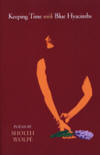Keeping Time with Blue Hyacinths
In Keeping Time with Blue Hyacinths, Sholeh Wolpé meditates on loss through succinct, tightly crafted lyric poems. Divided into four sections that call back to one another, Wolpé’s second poetry collection garners strength from its devotion to the quietude and magnitude of simple, clean lines with poignant yet oftentimes harsh imagery. With a keen understanding of how to create startling images, Wolpé provides access to a wider array of readers wishing to gain insight from these poems’ emotional clarity and depth. Although the majority of these poems are brief, their impression lasts.
In Keeping Time with Blue Hyacinths, Sholeh Wolpé meditates on loss through succinct, tightly crafted lyric poems. Divided into four sections that call back to one another, Wolpé’s second poetry collection garners strength from its devotion to the quietude and magnitude of simple, clean lines with poignant yet oftentimes harsh imagery. With a keen understanding of how to create startling images, Wolpé provides access to a wider array of readers wishing to gain insight from these poems’ emotional clarity and depth. Although the majority of these poems are brief, their impression lasts.
Intimacy laces the collection as the speaker tries to navigate relationships between lover, husband, and children. While sometimes these relationships are related through narrative, the most powerful poems rely on poetic devices such as simile and metaphor. In “Matrimony,” the entirety of the poems reads:
The sheer curtain she hangs between
two open windows becomes
the tongue of the wind—
a dialogue between landscapes.
But the windows close,
and the curtain falls
into an unbreakable hush.
By employing only metaphor to describe these abstract and complex terms, the poems do not sink into the explanatory or sentimental; instead, they read as true. In “Divorce,” a brief five-line poem, the speaker describes “the wide-eyed Barbie, / the deflated basketball.” Objects take on their own lives and significance by just existing, and existing can be difficult.
In turning to childhood and adolescence, Wolpé employs emotional turmoil in the same kind of brief lyrics with short, tight lines. In “Best Friend,” the speaker claims “She is violent with her skin.” At the poem’s end:
For this,
her body still,
soul numb-cold as a river,
forever keeps on
moving away.
Similar to “Best Friend,” in “Footnotes of a Sour Savoir,” the speaker says: “Death is a bearded vagrant pushing a cart / and love is but a shadow, / coreless and crumbling, like purity.” And “God is always leaving, leaving.” This sense of departure and movement carries significant weight without feeling too heavy or difficult for the reader.
The final poem sequence, “Keeping Time with Blue Hyacinths,” is described as “A Nowruz Sonata in 7 Movements” and is accompanied with a glossary of Persian words and key figures. Through the lyric-narrative, the speaker describes her mother’s “haft-sin table for Nowruz,” complete with “A goldfish in a crystal bowl; an egg / that will roll when the bull tosses / the world over to its other horn” in “1st Movement.” By the “6th Movement,” the speaker’s tone has altered, claiming:
How I tremble
before this table, a shimmering reflection
in a thousand mirrors of a tall
shapely woman.
Noting the passage of time, the speaker begins to view this table setting that marks the New Year as older, no longer childlike and unassuming.
Keeping Time with Blue Hyacinths maintains its nuance and dedication to craft through transforming emotionally fraught meditations into small poems retaining the significant of those events. Nothing is diminished.





